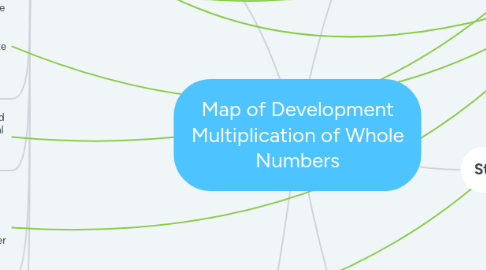
1. Typical Sequence of Development
1.1. Represent groups of objects and count each object by ones
1.2. Skip Count
1.3. Repeated Addition
1.4. Repeated Addition with Regrouping
1.5. Doubling
1.6. Doubling and Halving
1.7. Using Partial Products
2. Strategies
2.1. Using Models to Represent Multiplication (E.g., Base ten Blocks to represent groups)
2.2. Number lines to show skip counting 5X2=10 On a number line start skip count by 5's 2 times and you end up at 10
2.3. Arrays
2.3.1. Open Arrays
2.3.2. Splitting Arrays into Parts
2.3.3. Compensation 15X15 is easier to do if we change it to 20X15 and remove the extra 75
2.4. Partial Product
2.4.1. Decomposing into Tens and Ones 25X 15 can be decomposed into 2X1 and 5X5
2.4.2. By place Value 25X15 can be broken into place values of 20X10 and 5X5
2.5. Regrouping
2.5.1. The Associative Property (2X3) X6 = 2 X (3 X 6)
2.6. Estimating by Rounding numbers
3. Big Idea
3.1. NUMBERS — The set of real numbers is infinite, and each real number can be associated with a unique point on the number line.
3.2. THE BASE TEN NUMERATION SYSTEM — The base ten numeration system is a scheme for recording numbers using digits 0-9, groups of ten, and place value.
3.3. EQUIVALENCE: Any number, measure, numerical expression, algebraic expression, or equation can be represented in an infinite number of ways that have the same value.
3.4. OPERATION MEANINGS & RELATIONSHIPS: The same number sentence (e.g. 12-4 = 8) can be associated with different concrete or real-world situations, AND different number sentences can be associated with the same concrete or real-world situation.
3.5. PROPERTIES: For a given set of numbers there are relationships that are always true, and these are the rules that govern arithmetic and algebra.
3.6. BASIC FACTS & ALGORITHMS: Basic facts and algorithms for operations with rational numbers use notions of equivalence to transform calculations into simpler ones.
3.7. ESTIMATION: Numerical calculations can be approximated by replacing numbers with other numbers that are close and easy to compute with mentally. Measurements can be approximated using known referents as the unit in the measurement process.
3.8. PATTERNS: Relationships can be described and generalizations made for mathematical situations that have numbers or objects that repeat in predictable ways.
3.9. RELATIONS & FUNCTIONS: Mathematical rules (relations) can be used to assign members of one set to members of another set. A special rule (function) assigns each member of one set to a unique member of the other set.
3.10. EQUATIONS & INEQUALITIES: Rules of arithmetic and algebra can be used together with notions of equivalence to transform equations and inequalities so solutions can be found.
4. Models
4.1. Models to Represent a Mathematical Representation - Using base ten blocks to show a multiplication equation
4.2. Using a model to represent student thinking - Students can prove their thought processes by showing a model
4.3. Using a model to represent new learning - taking knowledge of arrays and changing that understanding into open arrays
5. Grade 4 Curriculum Expectations
5.1. Number Sense and Numeration
5.1.1. Multiplication
5.1.1.1. Overall Expectations • solve problems involving the addition, subtraction, multiplication, and division of singleand multidigit whole numbers, and involving the addition and subtraction of decimal numbers to tenths and money amounts, using a variety of strategies; • demonstrate an understanding of proportional reasoning by investigating whole-number unit rates.
5.1.1.1.1. Specific Expectations • multiply to 9 × 9 and divide to 81÷ 9, using a variety of mental strategies; • solve problems involving the multiplication of one-digit whole numbers, using a variety of mental strategies; • multiply whole numbers by 10, 100, and 1000, and divide whole numbers by 10 and 100, using mental strategies; • multiply two-digit whole numbers by one-digit whole numbers, using a variety of tools, student-generated algorithms, and standard algorithms; • use estimation when solving problems involving the addition, subtraction, and multiplication of whole numbers, to help judge the reasonableness of a solution; • describe relationships that involve simple whole-number multiplication; • demonstrate an understanding of simple multiplicative relationships involving unit rates, through investigation using concrete materials and drawings.

